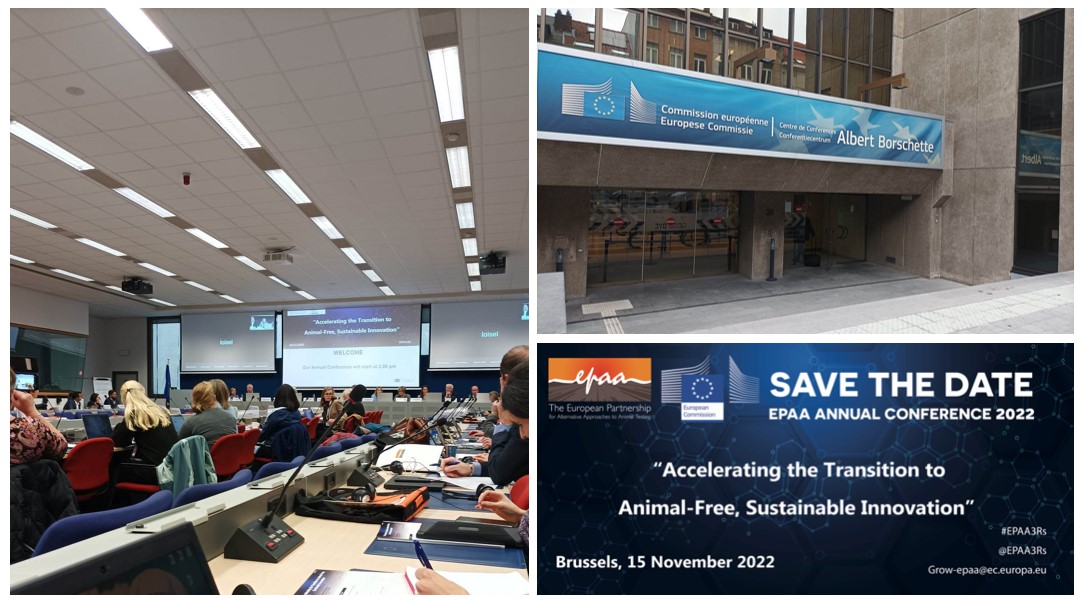EPAA 2022 Annual Meeting: How to increase confidence in NAMs
This year’s Annual Meeting of EPAA was held on the 15th of November 2022 in Brussels. Different stakeholders from European and international institutions, academic institutes, NGOs and regulators all participated in the event and presented their achievements to make the transition towards an animal-free, sustainable innovation a reality within the EU.
Accelerating the transition towards animal free research
Three keynote speakers kicked off the conference. Tilly Metz, chair of the EP Animal Welfare Intergroup, presented the European Partnership for Alternative Approaches to Animal Testing (EPAA) as a key platform to accelerate the transition to animal-free research. EPAA gathers and connects different stakeholders to increase the acceptance of NAMs and to implement them more in regulatory testing.
Joanna Drake, from DG Research and Innovation, confirmed the intention of the European Commission (EC) to phase out animal testing in Research, Regulatory Testing and Education. In this perspective, the EC has funded numerous projects on the development of alternative approaches, such as the ASPIS cluster and PARC. These projects will provide new and innovative tools to replace and/or reduce animal testing. Joanna stressed the importance of training young professionals as they will be the future regulators.
Marco Mensik, from the European Chemical Industry Council (CEFIC), highlighted the existing paradox between the need for animal-based test results to allow (new) compounds onto the market and the public/customer demand to avoid animal testing.
EPAA’s activities in 2022 and 2023
Gavin Maxwell, EPAA Industry co-chair, presented EPAA’s activities performed in 2022: support to several 3Rs related projects, provide several 3Rs students grants, contribute to the Helsinki Chemical Forum, maintain the EPAA partners forum, award the Science prize etc...
In 2023, EPAA plans to publish a roadmap on the replacement of animal testing for regulatory testing of chemicals and to organise a partner forum, a poster exhibition, and a workshop on phasing out the rabbit pyrogen test.
Animal-free innovation: drivers and vision
The following session of the conference was dedicated to applications of animal free innovation. Bob Van der Water, coordinator of the RISK-HUNTER project, highlighted the activities of the ASPIS cluster regarding the development of new advanced models, the acceptance of NAMs and their regulatory uptake. He indicated that the current validation procedure of NAMs is not sufficient. ‘NAMs are therefore not recognised as a reliable tool for chemical risk assessment’, confirmed Andrew Worth from DG environment.
However, NAMs could provide human relevant models that would be more appropriate to assess human safety, as Dr Carl Westmoreland (Unilever) pointed out. The main challenge is the lack of experience with NAMs and confidence in these new technologies. The society and involved stakeholders should trust the knowledge of experts working with NAMs, as they have previously trusted researchers working with animals.
Finally, the EMA, represented by Dr Sonja Beken, established a working party on 3Rs to monitor all 3R related activities in regulatory testing of Medicinal Products. This working party provides advice on the application of the 3Rs Principle to the Committee for Medicinal Products for Human Use and the Committee for Veterinary Medicinal Products.
EPAA 3Rs Science Prize
The conference was closed by the EPAA 3RS Science Prize Ceremony. This year, Amer Jamalpoor from Toxys was awarded for his impressive work on the case study "ReproTracker: an animal-free platform for developmental toxicity testing". Congratulations, Amer!


